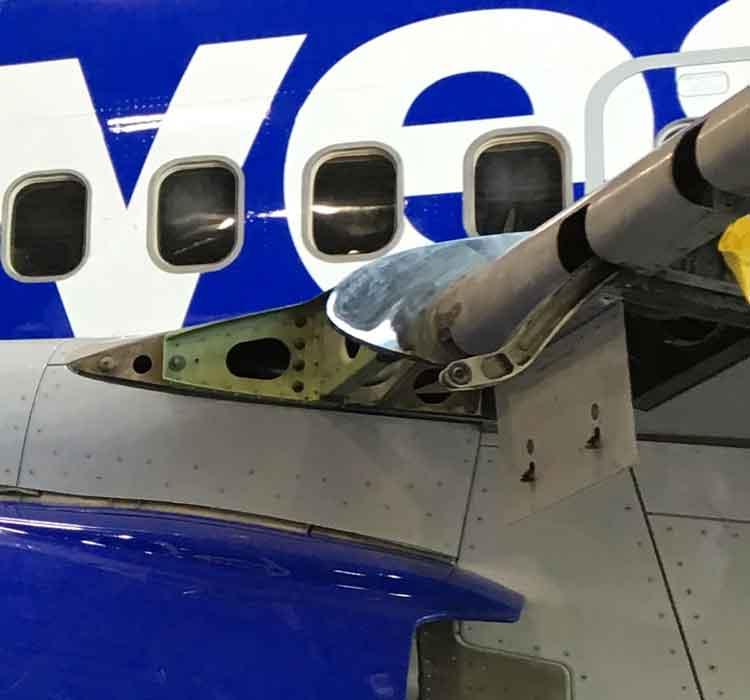- FMA
- The Fabricator
- FABTECH
- Canadian Metalworking
Categories
- Additive Manufacturing
- Aluminum Welding
- Arc Welding
- Assembly and Joining
- Automation and Robotics
- Bending and Forming
- Consumables
- Cutting and Weld Prep
- Electric Vehicles
- En Español
- Finishing
- Hydroforming
- Laser Cutting
- Laser Welding
- Machining
- Manufacturing Software
- Materials Handling
- Metals/Materials
- Oxyfuel Cutting
- Plasma Cutting
- Power Tools
- Punching and Other Holemaking
- Roll Forming
- Safety
- Sawing
- Shearing
- Shop Management
- Testing and Measuring
- Tube and Pipe Fabrication
- Tube and Pipe Production
- Waterjet Cutting
Industry Directory
Webcasts
Podcasts
FAB 40
Advertise
Subscribe
Account Login
Search
3D optical scanning gets bird-damaged 737 back in the skies fast
- October 9, 2019
- Product Release
- Shop Management
Situation
Birds and planes can be an expensive and disruptive mix, costing airlines worldwide billions of dollars in damages each year. Bird strikes in 2017 cost the civil aviation industry at least 71,253 hours of aircraft downtime, and the FAA estimates that $400 million in damages annually can be attributed to bird strikes in the U.S. alone. Despite various preventive measures aimed at reducing the number of strikes, it is clearly a problem that will continue to cause considerable trouble for airlines; FAA data shows that U.S.-based civilian flights reported 14,661 bird strikes in 2018—more than 40 a day.
Recently a major U.S. airline suffered bird damage to one of its Boeing 737’s wing ribs, requiring the aircraft to be grounded until repairs were made. Wing ribs are an essential part of a plane’s wing assembly. Attached to the spar, the main spanwise beam of an airplane wing, ribs form the skeleton of a wing’s structure, giving it its airfoil shape, helping distribute aerodynamic forces over a larger surface area, and making lift possible.
“In addition to removing, repairing, and restoring the damaged component, the airline also bears the cost of flight delays, cancellations, and missed connections,” said Steve Kersen, president of NVision. “The immense expense incurred by grounding the aircraft made restoring it to flight-worthiness an immediate and top priority.”
Resolution
Familiar with NVision’s aerospace work, the carrier sought the company’s help. NVision technicians traveled to the airline’s facilities and scanned the damaged wing rib using its HandHeld laser scanner, collecting all the necessary data on the rib’s exact geometry—its shape, size, and contours.
The portable scanner can capture 3D geometry from objects of almost any size or shape. It is attached to a mechanical arm that moves about the object, freeing the user to capture data rapidly with a high degree of resolution and accuracy. As a part is inspected, the scanner generates a point cloud comprising millions of points, each with XYZ coordinates and IJK vectors. Integrated software that comes with the scanner is used to convert the point cloud to an STL polygon, and an optional tripod provides complete portability in the field. Intuitive software allows real-time rendering, full model editing, polygon reduction, and data output to all standard 3D packages.
After converting the rib’s point cloud to an STL file, NVision technicians imported the file into specialized modeling software, where CAD engineers processed the data to an IGES/STEP model. Design engineers then created an insert to strengthen the rib and electronically transferred the manufacturable CAD model to the airline, where it was rapidly machined and installed, enabling the damaged plane to fly again just 48 hours after the strike.
subscribe now

The Fabricator is North America's leading magazine for the metal forming and fabricating industry. The magazine delivers the news, technical articles, and case histories that enable fabricators to do their jobs more efficiently. The Fabricator has served the industry since 1970.
start your free subscription- Stay connected from anywhere

Easily access valuable industry resources now with full access to the digital edition of The Fabricator.

Easily access valuable industry resources now with full access to the digital edition of The Welder.

Easily access valuable industry resources now with full access to the digital edition of The Tube and Pipe Journal.
- Podcasting
- Podcast:
- The Fabricator Podcast
- Published:
- 04/16/2024
- Running Time:
- 63:29
In this episode of The Fabricator Podcast, Caleb Chamberlain, co-founder and CEO of OSH Cut, discusses his company’s...
- Trending Articles
AI, machine learning, and the future of metal fabrication

Employee ownership: The best way to ensure engagement

Steel industry reacts to Nucor’s new weekly published HRC price

Dynamic Metal blossoms with each passing year

Metal fabrication management: A guide for new supervisors

- Industry Events
16th Annual Safety Conference
- April 30 - May 1, 2024
- Elgin,
Pipe and Tube Conference
- May 21 - 22, 2024
- Omaha, NE
World-Class Roll Forming Workshop
- June 5 - 6, 2024
- Louisville, KY
Advanced Laser Application Workshop
- June 25 - 27, 2024
- Novi, MI


























